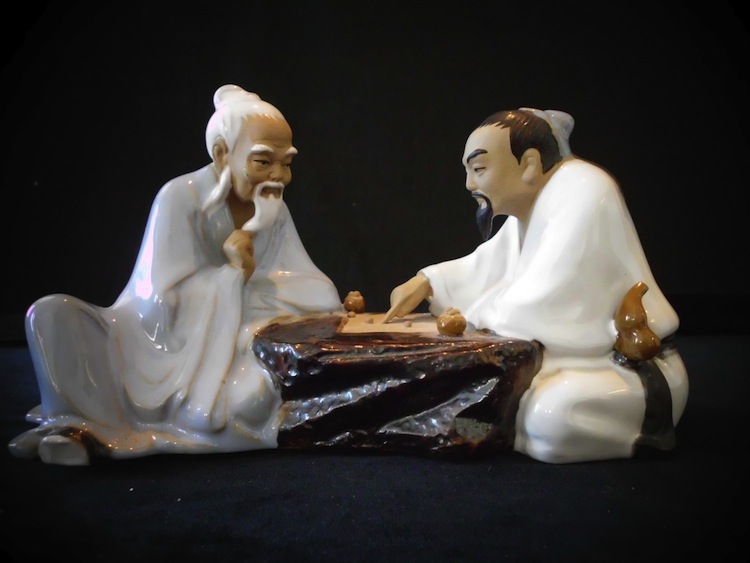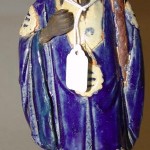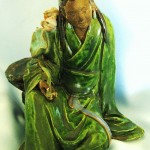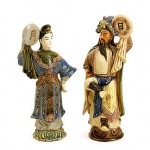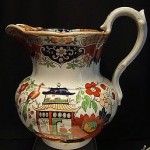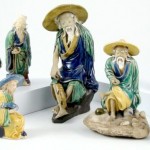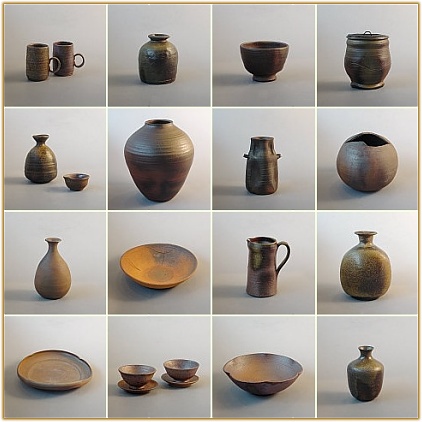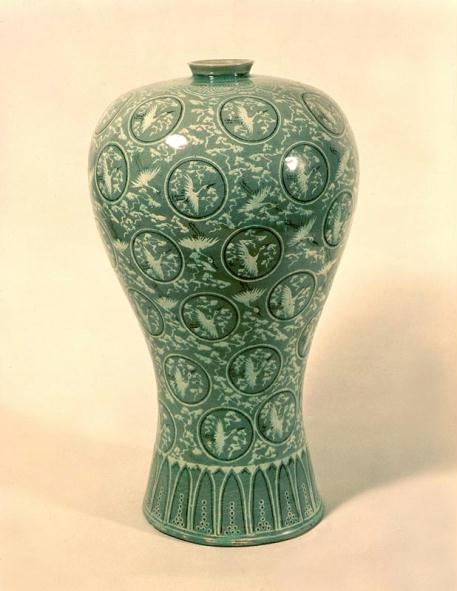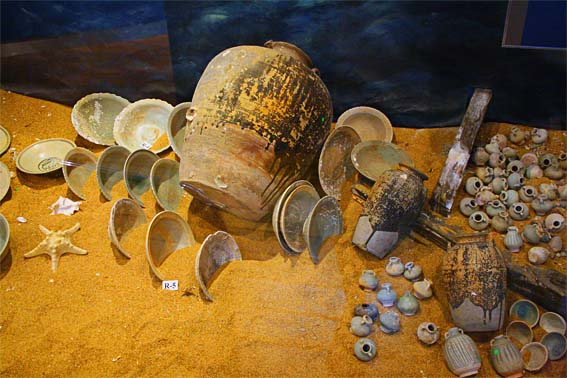1000 years ago, Chinese artisans of the Tang Dynasty (618-907 AD), were creating miniature landscapes in a tray, the practice was known as Pen’Jing, or Chinese Landscape bonsai.
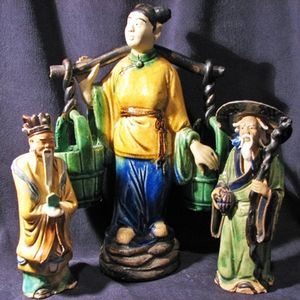 In an effort to capture the realism of a favourite scenic view, such as a countryside or mountain region, rocks and small trees were planted in a large ceramic tray to simulate the panorama on a smaller scale. If one were to view the scene, a harmonious feeling of having visited the area could be bought to mind and the viewers thoughts refreshed.
In an effort to capture the realism of a favourite scenic view, such as a countryside or mountain region, rocks and small trees were planted in a large ceramic tray to simulate the panorama on a smaller scale. If one were to view the scene, a harmonious feeling of having visited the area could be bought to mind and the viewers thoughts refreshed.
An intricate part of that illusion would involve the use of figurines which were of people, animals, huts and temples, which helped to give an appearance of great age and size to the miniature forests. The reason for including this record in this article is to establish the fact that figurines have always had a place in Bonsai as an aesthetic contribution. The Japanese dropped the use of figurines from their version of Bonsai about 400 years ago in order to conform the Oriental Art to their idealistic idiom. Pen’Jing is apparently experiencing a revival in modern day China, it is a nearly lost art form that is once again becoming popular with Chinese bonsai enthusiasts.
The Ching or Manchurian dynasty (1644-1912), one of the most prosperous during the age of the dynasties, began it’s decline at the end of the 18th century. Having established an export market for fine china in the previous years would now be unable to sustain the type of quality and production that had defined the era. Some experts blame the reason on internal strife, in-house fighting and excess competition for the wares as the primary cause.
Cheap pottery and figurines would dominate the Chinese export trade well into the next century. Now enters the ‘mudman’. Mudmen were brightly glazed figurines of women, wise men and old sages, sometimes fishing, seated or standing, holding flutes, scrolls, pots, fish and other objects of mystical importance.
The thing that separates these figurines from the ordinary, is that they were made individually by hand. It has been suggested this was a ‘cottage industry’ involving nearly every member of the village in the production of these oriental curios. As the story goes, when the harvesting of rice was complete and the dry season had set in, the villagers turned to figurine production as a means of establishing a vigorous economy. This accounts for the varying degrees of quality apparent in each of the pieces.
The ‘mud’ or clay for the figures was pressed into a mould by hand, at this point each part would be individually moulded to be assembled by the various crafters at the appropriate time. Fingerprints can often still be seen, immortalised in the fired clay. After the torso was released from the mould, the head, hands and legs or feet would be added. Then hair, hats, beards and other items would complete the ensemble. As a finishing touch, eyes, nose and ears would be pierced to add further detail. Then the entire collection of the works would be fired in a kiln to cure the clay.
The mudmen were hand painted with a low temperature lead glass glaze in the traditional ‘yellow mustard’ and ‘cerulean blue’, ‘celadon’ a green glaze, has been suggested as being used to represent ‘jade’. Finally, the occasional use of white or brown was used to break the monotony of the tri-colours. The head, hands and face were left unglazed to expose the natural colour of the mud that was often enough, a flesh tone. The rocks upon which some mudmen were seated, shoes or sandals, were painted with a dark brown, almost black under-glaze, that was often used to paint hair and facial features as well. I have seen some examples of the rocks painted a red oxide or yellow ochre in other pieces.
It has been proposed that the darker the clay, the older, hence more valuable, the mudman is. This is considered a myth by most knowledgeable collectors who know that the differences in the mud colour account more for the region than for the age of the piece. The darker mud’s were dug from the lower valleys where soil impurities and water runoff have tinted the clay. The mud colour can range from a dark grey or brown to a buff or peach and even creamy white, used more often than not for the mud women.
The certain age of an antique mudman can be verified by observing the mark incised on the bottom of the figure. As all imports into the US had to have the point of origin plainly stamped within view, the pottery stamps can actually date the piece. 1890-1919 ‘China’, 1920-1944 ‘made in China’ or ‘made in Hong Kong’ and occasionally ‘made in China’, stamped in red ink during the late 1940’s. If you have a figurine which has no mark stamped on it, the probable reason is it was not intended for export and was more likely purchased at a village market by missionaries or world travellers.
The absence of the original mudman figure from Chinese export markets after World War 2, have some collectors believing that the earliest moulds were destroyed along with the kilns by bombing raids. Others have suggested that the kilns used for pottery were converted to weapons manufacture to help counter the Japanese invasion prior to the war and were destroyed by enemy soldiers, and subsequently, the moulds were lost as well, never to be recovered.
Today, the antique mudman is a highly collectible item, surviving examples were showcased in a large exhibition at the Hong Kong Fung Ping Shan Museum in 1979 and at the Chinese Culture Centre in San Francisco in 1994.
The ‘holy grail’ of mudman collecting, if such a term can be applied, would be the ever elusive ‘mud woman’, She is a rare item indeed, adding one of these to my collection is paramount to winning the Grand Prize in a lottery! I have yet to find one in an antique shop or win an online auction for one of these beauties.
Mudman figurines can range in size from 2″ to 18″ and sometimes larger, the 4″ to 7″ model was the most popular export, mainly due to the available retail shelving space. Surviving mud figures, for the most part, have knicks to the hair and outer extremities, broken and repaired heads, hands, beards etc. It’s not uncommon to find them in good condition with very little damage or no repairs, and sometimes in mint condition, I have several in that category and many in the latter. Though it has been estimated that 5% of the remaining mud figures are lost annually due accident or natural disaster, the chances of acquiring one are still good, but numbers will continue to decline.
In the early 1950’s, the Chinese export companies began a new era of mudman production that continues until the present. However, the newer figurines lack the expression and individuality that only a handmade item can convey, all of the experience and talent that went into the original, is lost in the mechanized world of capitalism, and for that matter, pales into comparison to the character and aesthetic beauty of the turn of the century mudman.

